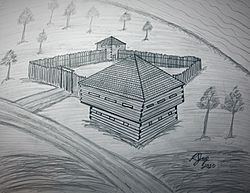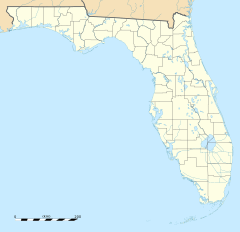Fort Basinger (Seminole War Fort) facts for kids
Quick facts for kids Fort Basinger |
|
|---|---|
| Approximately 35 miles west of Fort Pierce along U. S. Highway 98 in Highlands County, Florida. in United States | |

Fort Basinger - Second and Third Seminole War Fort (artist's depiction).
|
|
|
Location of Fort Basinger
|
|
| Coordinates | 27°21′46″N 81°03′10″W / 27.36278°N 81.05278°W |
| Site information | |
| Condition | Completely destroyed. |
| Site history | |
| Built | 1837 |
| Built by | United States Army |
| In use | 1837-1858 |
| Materials | Pine logs (stockade and two blockhouses). |
| Fate | Abandoned after the Third Seminole War (1855–1858) and eroded away. |
| Battles/wars | Battle of Lake Okeechobee |
| Events | Fort Basinger was built as a supply garrison and for prisoner detention, and aided wounded troops after the Battle of Lake Okeechobee. |
| Garrison information | |
| Past commanders |
Colonel Zachary Taylor |
| Garrison | Regular army troops and Militia. |
Fort Basinger was a military fort built in 1837 by the United States Army. It was located about 35 miles (56 km) west of Fort Pierce, Florida in Highlands County, Florida. The fort was made of pine logs and had a stockade (a fence of strong posts) and two blockhouses (small forts).
This fort was one of many military outposts created during the Second Seminole War. Its main purpose was to help Colonel Zachary Taylor's soldiers. They were trying to capture or confront the Seminole people and their allies in central Florida. The Seminole people were resisting being forced to move from their lands. This forced movement was part of a government plan called the Indian Removal Act.
Contents
Why Was Fort Basinger Built?
In 1837, Colonel Zachary Taylor was leading his troops in the Second Seminole War. On December 2, 1837, he ordered the building of Fort Gardiner. This was part of his plan to move into the Lake Okeechobee area.
Colonel Taylor soon realized he needed another fort further south. So, on December 21, 1837, he ordered Fort Basinger to be built. The fort was named after Lieutenant William E. Basinger. He was a brave officer who died in an important battle.
Colonel Taylor put Captain Monroe of the 4th Artillery in charge of Fort Basinger. Captain Monroe was responsible for finishing the fort's construction. He also commanded one company of soldiers and about 85 sick or injured men, along with some Native Americans, who stayed at the fort.
Fort Basinger and the Battle of Lake Okeechobee
After Fort Basinger was started, Colonel Taylor's main group of soldiers marched south. On December 25, 1837, they fought in the Battle of Lake Okeechobee. This was a very tough battle.
Colonel Taylor's troops suffered many losses. Twenty-six soldiers were killed, and 112 were wounded. They had to go back to Fort Basinger. The fort became a place for the wounded soldiers to rest.
After a short time at Fort Basinger, the troops moved to Fort Gardiner. There, they set up a temporary hospital. Many seriously wounded soldiers were then taken to Fort Brooke for more medical care.
Fort Basinger continued to be used after the Second Seminole War ended. It was also used by the U.S. Army and local soldiers during the Third Seminole War (1855–1858). Eventually, the fort was no longer needed. It was abandoned and slowly fell apart over time. Today, nothing remains of the original fort.
Who Was William Elon Basinger?
Fort Basinger was named after Lieutenant William Elon Basinger. He was born on September 27, 1806, in Savannah, Georgia. His family had a history of supporting American independence. His great-grandfather, Peter Tondee, owned a tavern in Savannah. This tavern was a meeting place for people who wanted to break free from British rule.
William Basinger became a cadet at the United States Military Academy in West Point, New York. He started there on July 1, 1826. He was a very good student. He graduated second in his class on July 1, 1830, without getting any demerits (punishments). He was promoted to Second Lieutenant in the 2nd Artillery.
Basinger served in various military locations. In 1835, he was sent to Tampa Bay, Florida. His job was to help prepare defenses against the Seminole people who were resisting.
On December 23, 1835, Lieutenant Basinger was part of a group of soldiers. They were led by Major Francis L. Dade and were marching from Tampa to Fort King. On December 28, 1835, this group was attacked by Seminole warriors. The attack was led by Chief Micanopy and Chief John Jumper.
This battle became known as Dade's Massacre. Lieutenant Basinger was the last officer to be killed. Only two soldiers and one guide survived the attack. This event marked the beginning of the Second Seminole War.
William Elon Basinger is buried in the St. Augustine National Cemetery in St. Augustine, Florida. Colonel Zachary Taylor spoke at his burial. He said that Basinger was like a son to him. Taylor also believed that the United States had lost a soldier who would have become a great general.
Where Was Fort Basinger Located?
Today, you won't find any old buildings or ruins of Fort Basinger. The fort has completely disappeared over time. However, its historical site is marked.
There is a special sign from the Florida Board of Parks and Historic Memorials. This sign is located in Highlands County, Florida. It tells visitors about the fort's history.
The sign explains that Colonel Zachary Taylor built Fort Basinger in 1837. It was a small stockade fort and a supply station. It was part of a line of forts that stretched from Tampa to Lake Okeechobee. The sign also mentions that the fort was named after Lieutenant William E. Basinger. It states that the fort was abandoned after the Indian Wars ended.



